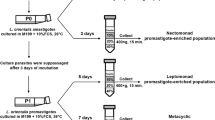Abstract
Several methods of cultivation of Leishmania parasites are available, and among them, biphasic media like Nicolle–Novy–MacNeal medium are considered to be superior for the initial isolation of the parasites and their in vivo infectivity. In the present work, the efficacy of sheep blood–LB agar base medium (SLM) was evaluated for the cultivation of Leishmania major promastigotes. The SLM supports the proliferation of the parasites and can be used for routine isolation and cultivation of Leishmania parasites with acceptable in vivo infectivity for research purposes.
Similar content being viewed by others
Avoid common mistakes on your manuscript.
Introduction
In vitro cultivation of hemoflagellates of the genera Trypanosoma and Leishmania has progressed from crude media with undefined ingredients to fully defined media with serum substitutes capable of supporting good to excellent proliferation of the organisms (Schuster and Sullivan 2002). Nicolle–Novy–MacNeal (NNN) medium was first used by Nicolle (1908) for the isolation of the agent of cutaneous leishmaniasis, and indeed, its original formulation, traditional diphasic blood medium, remains useful for the establishment of strains in culture and for the initial isolation of parasites (Evans 1987). Here, we describe new insights from an old NNN biphasic medium (Nicolle 1908) to cultivate Leishmania on sheep blood–LB agar base medium (SLM), a simple and suitable medium for the obtention Leishmania major promastigotes, which combines some advantages of both biphasic and liquid media.
Materials and methods
SLM consists of 20 ml Luria-Bertani (LB) agar plus (20 %) defibrinated sheep blood as the base that is poured into 25-cm2 cell culture flasks at a slightly inclined position and of 5–10 ml LB broth as the liquid overlay (Fig. 1). L. major promastigotes (MRHO/IR/76/ER) were cultured in SLM at five repeated series, and in each one, triplicate cultures were prepared and were placed in an incubator at 26 °C. Parasite proliferation and count were assessed qualitatively and quantitatively by microscopic observations and Giemsa slide preparation. L. major promastigotes at stationary phase were inoculated subcutaneously into the tail base of BALB/c mice (6–7 weeks) and animals were evaluated macroscopically, and after appearance of lesions, biopsy and inoculation on SLM were performed. All experiments were in accordance with and approved by the Institutional Animals Ethics Committee of Razi Vaccine and Serum Research Institute.
Results
Results showed that in Giemsa-stained smears, finely grown parasites with the typical morphology were observed, and under inverted microscope, it was shown that the promastigotes were elongated, with good motility. The SLM supported the continuity of the parasites in successive passages. Four weeks after infecting BALB/c mice with L. major promastigotes, typical cutaneous lesions of leishmaniasis were observed in the tail base of all experimental animals, and after inoculation of the biopsied material to the medium, it was confirmed that SLM could support the transformation of amastigote to promastigote and could be used for in vivo researches.
Discussion
The cultivation of Leishmania and other hemoflagellates has been a subject of much interest due the necessity of performing biochemical and immunological studies with isolated parasites in an effort to develop future therapeutic and preventive tools (Palomino 1982).
Blood, preferentially from rabbit, is an essential component of NNN medium (Chang and Fish 1983; Evans 1987); however, the obtention of rabbit blood is painful and sometimes lethal due to cardiac puncture. The detection of intracellular amastigote-like bodies in a biopsied section from the pinna of a sheep in South Africa (van der Lugt et al. 1992) pointed to the possibility of using blood and serum of this animal for the cultivation of Leishmania parasites. In comparison to NNN medium, the large volume of LB broth (5–10 ml) as liquid overlay makes the medium suitable for large-scale purposes and the specific inclined position of the medium in 25-cm2 flasks facilitated its monitoring by an inverted microscope, which was the main advantage of SLM. Inclusion of other Leishmania species and using the SLM for the primary isolation of clinical field isolates can be the next important steps in this research and are the specific limitations of our study.
In conclusion, the results showed that cultivation of L. major promastigotes in SLM provides parasites with acceptable growth behavior and in vivo infectivity for research purposes. The simplicity of SLM preparation makes it useful for primary isolation and routine cultivation of Leishmania parasites.
References
Chang KP, Fish WR (1983) Leishmania. In: Jensen JB (ed) In vitro cultivation of protozoan parasites. CRC, Boca Raton, pp 111–145
Evans DA (1987) In: Taylor AER, Baker JR (eds) In vitro methods for parasite cultivation: Leishmania. Academic, New York, pp 52–75
Nicolle C (1908) Culture du parasite du bouton d’Orient. CR Acad Sci 146:842–843
Palomino JC (1982) Peptone-yeast autolysate-fetal bovine serum 10, a simple, inexpensive liquid medium for cultivation of Leishmania spp. J Clin Microbiol 15(5):949–950
Schuster FL, Sullivan JL (2002) Cultivation of clinically significant hemoflagellates. Clin Microbiol Rev 15:374–389
van der Lugt JJ, Carlyon JF, de Waal DT (1992) Cutaneous leishmaniasis in a sheep. J S Afr Vet Assoc 63:74–77
Conflict of interest
The author declares that no competing financial interests exist in this investigation.
Author information
Authors and Affiliations
Corresponding author
Rights and permissions
Open Access This article is distributed under the terms of the Creative Commons Attribution License which permits any use, distribution, and reproduction in any medium, provided the original author(s) and the source are credited.
About this article
Cite this article
Nasiri, V. Sheep blood–LB agar base medium (SLM) as a simple and suitable medium for the cultivation of Leishmania major promastigotes. Parasitol Res 112, 3741–3742 (2013). https://doi.org/10.1007/s00436-013-3560-7
Received:
Accepted:
Published:
Issue Date:
DOI: https://doi.org/10.1007/s00436-013-3560-7





